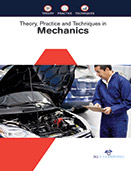Engineering and Technology

Mechanics is an area of science concerned with the behavior of physical bodies when subjected to forces or displacements, and the subsequent effects of the bodies on their environment. Mechanics is a vast field too-classical, quantum, fluid etc. It can be studied under main two topics which are kinematics concerning the motion of the particle and dynamics concerning the causes of motion. Most of the phenomena in the world around you are, at the fundamental level, based on physics, and much of physics is based on mechanics. Mechanics begins by quantifying motion, and then explaining it in terms of forces, energy and momentum. This allows us to analyze the operation of many familiar phenomena around us, but also the mechanics of planets, stars and galaxies.
The entitle text “Theory, Practice and Techniques in Mechanics” unravels those fundamental physical principles which explain how all matter behaves. It is intended to the foundation of mechanics, namely classical Newtonian mechanics, principle of relativity and Hamilton’s principle of least action. This text starts with the mechanics of units and dimensions as well as mechanics of vectors. Further, deals with mechanics of materials includes, for example, the study of materials used to make shoes, materials used to make or those to be worn in shoes to treat certain foot disorders, and the effects of ageing on bone, muscle and connective tissues. It illustrates the theory of mechanisms and vibrations in addition to forces in structures with mechanics of materials in terms of forces, deformations, and stability. It also deals with thermodynamic systems and closes with the theoretical framework for constructing quantum mechanical models of subatomic particles in particle physics and quasiparticles in condensed matter physics.
This book should demonstrate that students have the ability to